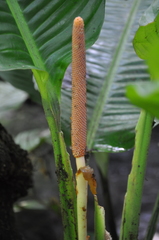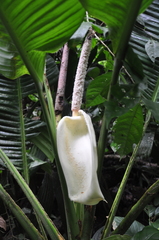

|
|
|
|
Family: Araceae
|
Terrestrial; caudex thick, mostly or entirely creeping over the ground, usually less than 1 m long, to 5 cm diam below leaves, tapering to a narrow end entering the soil, secured by smaller roots along its length. Leaves closely spaced, imbricate; petioles minutely speckled with light green, on adult plants usually 30-50 cm long, vaginate-winged about three-fourths its length, one side higher, to 2.5 cm wide at base, +/- nodose and geniculate just below blade; blades broadest in middle and tapering evenly to both ends, short-acuminate at apex, cuneate to obtuse at base, usually 50-76 cm long, 20-42 cm wide, glabrous or minutely papillate, dark green and glossy above, light brownish-green below, densely covered with minute reddish-brown spots, midrib sunken and light green above, raised below; major lateral veins in 24-34 pairs, somewhat impressed above, 10-25 mm apart. Inflorescences solitary in leaf axils; peduncles to 40 cm long; spathe boat-shaped, white, 15-26 cm long, with cuspidate apiculum ca 2.5 cm long, decurrent on and tightly enveloping spadix, to 12 cm broad when open, 5-6 cm deep, soon deciduous, the margins revolute; spadix uniform, salmon-pink, slightly shorter than spathe, densely many-flowered, short-stipitate, cylindrical, blunt on end, 16-20 mm wide, becoming covered with a sticky thick solution shortly after anthesis; flowers perfect, naked; stamens 4; anthers narrowly pointed; ovary ca 3 mm long, the sides angulate,l-locular but with a partial division suggesting 2 locules, each division containing 1 placenta with numerous ovules; style as broad as ovary; stigma linear. Berries small (mature berries not seen), prismatic, truncate; seeds minute (probably less than 0.5 mm), elbow-shaped, very numerous, embedded in a sticky matrix. Croat 11275,12297. Uncommon; locally abundant, occurring on steep, moist creek banks in the vicinity of the laboratory. Flowers principally throughout the middle to late rainy season (August to November). Fruiting inflorescences have never been seen, but fruits probably develop in a short time. Possibly confused with R. wendlandii, which is, however, always epiphytic as an adult. Simmonds's report (1950) of this species from Trinidad was possibly an error, because he described it as a high-climbing epiphyte, a habit I have never encountered among the exclusively terrestrial Panamanian specimens. Standley reported the species from Chiriqui (Burica Peninsula) on the basis of Woodson & Schery 929, but that specimen may be of another species of Rhodospatha. Costa Rica to Colombia and Venezuela. In Panama, probably restricted to the Atlantic slope and known from tropical moist forest in the Canal Zone and San Blas and from tropical wet forest in Colón. |






